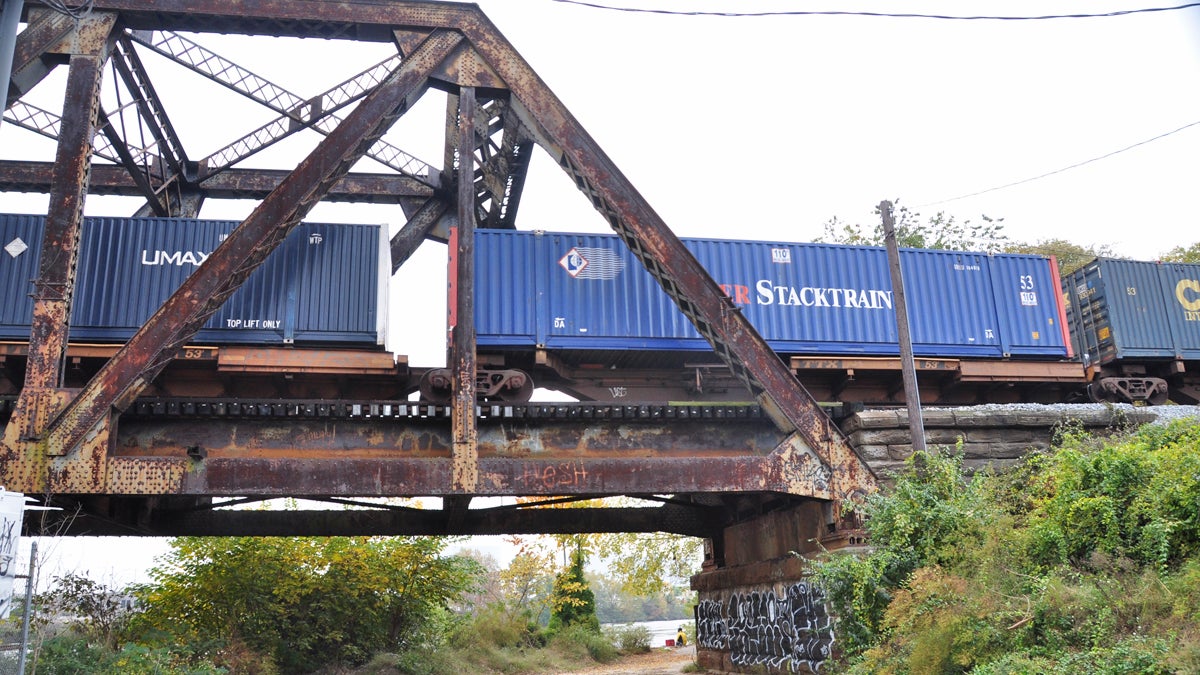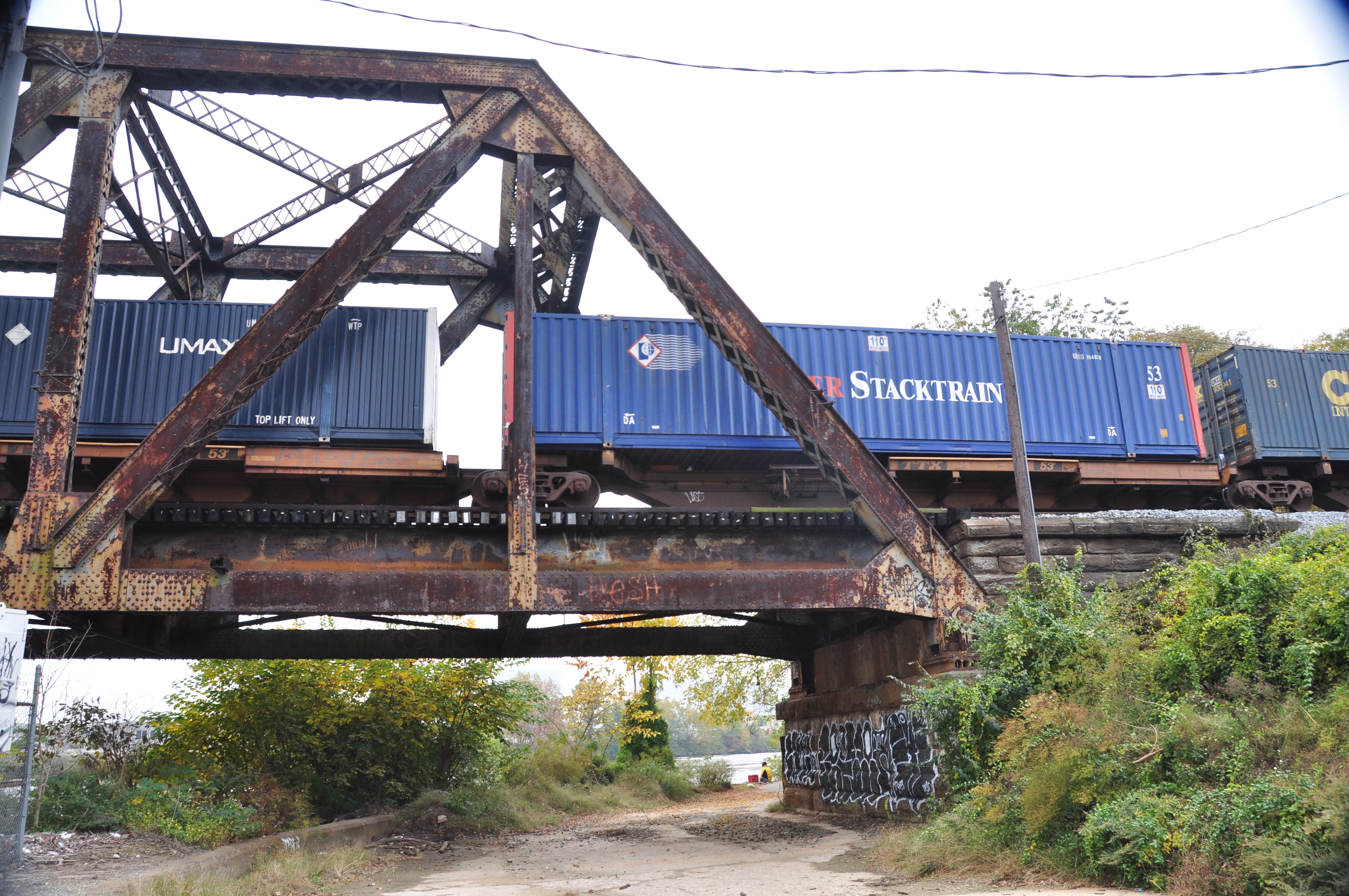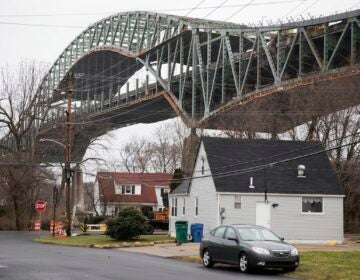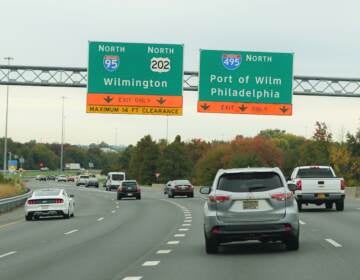Freight rail safety bill chugs along following hearing, to union delight

A freight train crosses a bridge in south Philadelphia. (PlanPhilly file image)
To hear Paul Pokrowka describe it, the average railroad engineer has little in common with Casey Jones.
To hear Paul Pokrowka describe it, the average railroad engineer has little in common with Casey Jones.
“I’d be lying to you if I told you I hadn’t fallen asleep running a train,” Pokrowka said. Pokrowka was testifying before the Pennsylvania House transportation committee earlier this month in a hearing on H.B. 1742, a bill to require all freight trains in Pennsylvania to have at least two crew members operating it at any given time.
Pokrowka was testifying in favor of the bill, introduced last month by Rep. Martina White, the freshman Republican representing District 170 in Northeast Philadelphia. Pokrowka was there in his capacity as a veteran railroader and as the Pennsylvania legislative director of the Sheet Metal, Air, Rail and Transportation Workers, an AFL-CIO affiliate.
White and her bill’s supporters characterized the bill as a common sense safety measure, saying it would have prevented the tragedy that befell the town of Lac-Mégantic, Canada. That small Quebecois town was engulfed in a fiery wave after a 74-car freight train carrying crude oil derailed. The accident, caused when the train rolled downhill after the engineer failed to properly set the brakes, killed 47 people.
Ken Kertesz, Pennsylvania legislative chairman for the Brotherhood of Locomotive Engineers and Trainmen, blamed the accident on that railroad’s recent decision to use one-person crews. The lone engineer had been working for twelve hours straight, hitting the maximum allowed under Canadian safety laws aimed at preventing accidents from sleep-deprivation. As a result, he had to stop the train, keeping it on to power the air brakes, and leave it for a relief engineer to take. Before that relief engineer arrived, though, the air brakes gave out, sending the train downhill on its way to the deadly derailment.
American railroads have similar work limits, which aim to prevent crashes caused by fatigue-fueled human error. A second engineer could have relieved the primary one, said Kertesz.
The bill has faced opposition from the Keystone State Railroad Association, which represents freight railroad operators in Pennsylvania. Rudy Husband, the association’s vice president, argued at the hearing that there have been no studies showing that two-person crews are safer. He also noted that Amtrak and other commuter rails don’t operate two-person engineering teams. According to Husband, “95 percent” of freight trains operate with two people; it’s mainly in rail yards that the trains operate with just one person.
California passed a similar two-person requirement law in 2015, and Alaska’s legislature is also considering a two-person requirement. Wisconsin, Arizona and West Virginia all have two-person crew laws on the books as well.
While nominally about safety, the battle lines fell along a predictable divide: unions supporting a bill that would require more labor and industry in opposition.
Following the meeting, House transportation committee Chairman John Rafferty (R-44) expressed his support for the bill, saying “Our job is really to use this as one tool to protect the public at large from any railroad disaster… and legislate a more safe environment.”
White’s bill only requires “two individuals” – not specifying between engineers and conductors, who serve a more supportive role to engineers on freight trains compared to their ticket-taking commuter railroad cousins.
Norfolk Southern and other railroads are now indicating that they won’t be able to meet the 2018 deadline to implement positive train control, a Congressionally mandated safety technology aimed at preventing crashes caused by human error. Congress extended the deadline last year when almost all railroads reported that they would not make the original end of 2015 deadline.
The bill would impose light fines on railroads found violating the two-person minimum, from no more than $1,000 for the first offense to a max of $10,000 for the third and subsequent offenses.
WHYY is your source for fact-based, in-depth journalism and information. As a nonprofit organization, we rely on financial support from readers like you. Please give today.
Freight Rail Safety bill chugs along following hearing, to union delight

To hear Paul Pokrowka describe it, the average railroad engineer has little in common with Casey Jones.
“I’d be lying to you if I told you I hadn’t fallen asleep running a train,” Pokrowka said. Pokrowka was testifying before the Pennsylvania House transportation committee earlier this month in a hearing on H.B. 1742, a bill to require all freight trains in Pennsylvania to have at least two crew members operating it at any given time.
Pokrowka was testifying in favor of the bill, introduced last month by Rep. Martina White, the freshman Republican representing District 170 in Northeast Philadelphia. Pokrowka was there in his capacity as a veteran railroader and as the Pennsylvania legislative director of the Sheet Metal, Air, Rail and Transportation Workers, an AFL-CIO affiliate.
White and her bill’s supporters characterized the bill as a common sense safety measure, saying it would have prevented the tragedy that befell the town of Lac-Mégantic, Canada. That small Quebecois town was engulfed in a fiery wave after a 74-car freight train carrying crude oil derailed. The accident, caused when the train rolled downhill after the engineer failed to properly set the brakes, killed 47 people.
Ken Kertesz, Pennsylvania legislative chairman for the Brotherhood of Locomotive Engineers and Trainmen, blamed the accident on that railroad’s recent decision to use one-person crews. The lone engineer had been working for twelve hours straight, hitting the maximum allowed under Canadian safety laws aimed at preventing accidents from sleep-deprivation. As a result, he had to stop the train, keeping it on to power the air brakes, and leave it for a relief engineer to take. Before that relief engineer arrived, though, the air brakes gave out, sending the train downhill on its way to the deadly derailment.
American railroads have similar work limits, which aim to prevent crashes caused by fatigue-fueled human error. A second engineer could have relieved the primary one, said Kertesz.
The bill has faced opposition from the Keystone State Railroad Association, which represents freight railroad operators in Pennsylvania. Rudy Husband, the association’s vice president, argued at the hearing that there have been no studies showing that two-person crews are safer. He also noted that Amtrak and other commuter rails don’t operate two-person engineering teams. According to Husband, “95 percent” of freight trains operate with two people; it’s mainly in rail yards that the trains operate with just one person.
California passed a similar two-person requirement law in 2015, and Alaska’s legislature is also considering a two-person requirement. Wisconsin, Arizona and West Virginia all have two-person crew laws on the books as well.
While nominally about safety, the battle lines fell along a predictable divide: unions supporting a bill that would require more labor and industry in opposition.
Following the meeting, House transportation committee Chairman John Rafferty (R-44) expressed his support for the bill, saying “Our job is really to use this as one tool to protect the public at large from any railroad disaster… and legislate a more safe environment.”
White’s bill only requires “two individuals” – not specifying between engineers and conductors, who serve a more supportive role to engineers on freight trains compared to their ticket-taking commuter railroad cousins.
Norfolk Southern and other railroads are now indicating that they won’t be able to meet the 2018 deadline to implement positive train control, a Congressionally mandated safety technology aimed at preventing crashes caused by human error. Congress extended the deadline last year when almost all railroads reported that they would not make the original end of 2015 deadline.
The bill would impose light fines on railroads found violating the two-person minimum, from no more than $1,000 for the first offense to a max of $10,000 for the third and subsequent offenses.
This piece was produced in collaboration with Keystone Crossroads.
WHYY is your source for fact-based, in-depth journalism and information. As a nonprofit organization, we rely on financial support from readers like you. Please give today.






